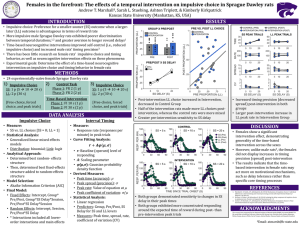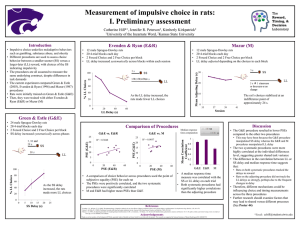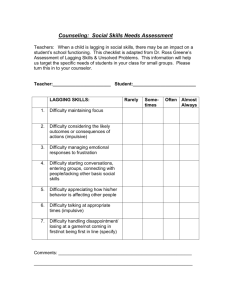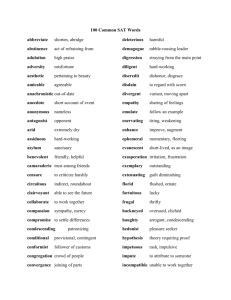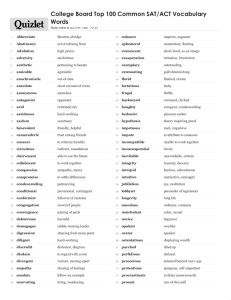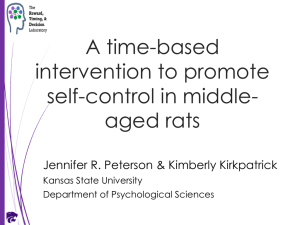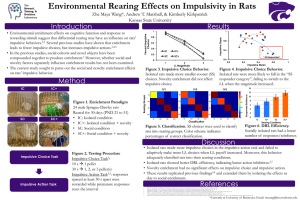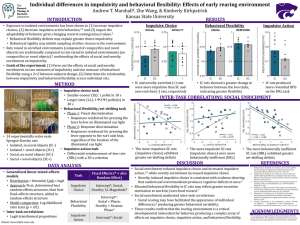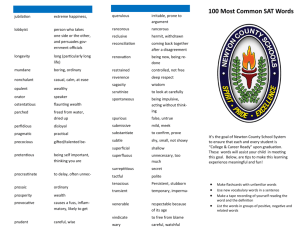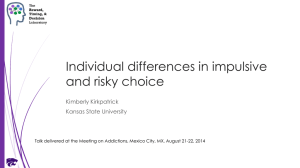The Role of Timing Processes in Three Different Impulsive Choice... Jennifer R. Peterson,* Catherine Hill, & Kimberly Kirkpatrick Kansas State University DESIGN
advertisement
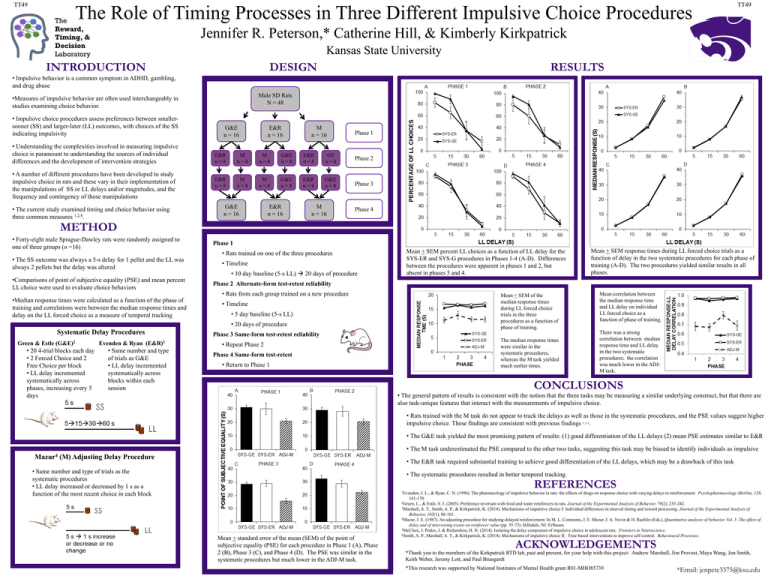
TT49 The Role of Timing Processes in Three Different Impulsive Choice Procedures TT49 Jennifer R. Peterson,* Catherine Hill, & Kimberly Kirkpatrick Kansas State University INTRODUCTION DESIGN RESULTS • Impulsive behavior is a common symptom in ADHD, gambling, and drug abuse Male SD Rats N = 48 •Measures of impulsive behavior are often used interchangeably in studies examining choice behavior. • Impulsive choice procedures assess preferences between smallersooner (SS) and larger-later (LL) outcomes, with choices of the SS indicating impulsivity • Understanding the complexities involved in measuring impulsive choice is paramount to understanding the sources of individual differences and the development of intervention strategies • A number of different procedures have been developed to study impulsive choice in rats and these vary in their implementation of the manipulations of SS or LL delays and/or magnitudes, and the frequency and contingency of those manipulations • The current study examined timing and choice behavior using three common measures 1,2,4. G&E n = 16 E&R n = 16 M n = 16 Phase 1 E&R n=8 M n=8 M n=8 G&E n=8 E&R n=8 GE n=8 Phase 2 E&R n=8 M n=8 M n=8 G&E n=8 E&R n=8 G&E n=8 Phase 3 G&E n = 16 E&R n = 16 M n = 16 Phase 4 METHOD • Forty-eight male Sprague-Dawley rats were randomly assigned to one of three groups (n =16) • The SS outcome was always a 5-s delay for 1 pellet and the LL was always 2 pellets but the delay was altered •Comparisons of point of subjective equality (PSE) and mean percent LL choice were used to evaluate choice behaviors •Median response times were calculated as a function of the phase of training and correlations were between the median response times and delay on the LL forced choice as a measure of temporal tracking Phase 1 • Rats trained on one of the three procedures • Timeline • 10 day baseline (5-s LL) 20 days of procedure Mean + SEM percent LL choices as a function of LL delay for the SYS-ER and SYS-G procedures in Phases 1-4 (A-D). Differences between the procedures were apparent in phases 1 and 2, but absent in phases 3 and 4. Phase 2 Alternate-form test-retest reliability • Rats from each group trained on a new procedure Mean + SEM of the median response times during LL forced choice trials in the three procedures as a function of phase of training. • Timeline • 5 day baseline (5-s LL) • 20 days of procedure Systematic Delay Procedures (G&E)2 Phase 3 Same-form test-retest reliability (E&R)1 Green & Estle Evenden & Ryan • 20 4-trial blocks each day • Same number and type • 2 Forced Choice and 2 of trials as G&E Free Choice per block • LL delay incremented • LL delay incremented systematically across systematically across blocks within each phases, increasing every 5 session days Mean + SEM response times during LL forced choice trials as a function of delay in the two systematic procedures for each phase of training (A-D). The two procedures yielded similar results in all phases. The median response times were similar in the systematic procedures, whereas the M task yielded much earlier times. • Repeat Phase 2 Phase 4 Same-form test-retest • Return to Phase 1 Mean correlation between the median response time and LL delay on individual LL forced choice as a function of phase of training. There was a strong correlation between median response time and LL delay in the two systematic procedures; the correlation was much lower in the ADJM task. CONCLUSIONS • The general pattern of results is consistent with the notion that the three tasks may be measuring a similar underlying construct, but that there are also task-unique features that interact with the measurements of impulsive choice. • Rats trained with the M task do not appear to track the delays as well as those in the systematic procedures, and the PSE values suggest higher impulsive choice. These findings are consistent with previous findings 3, 5, 6. • The G&E task yielded the most promising pattern of results: (1) good differentiation of the LL delays (2) mean PSE estimates similar to E&R • The M task underestimated the PSE compared to the other two tasks, suggesting this task may be biased to identify individuals as impulsive Mazur4 (M) Adjusting Delay Procedure • The E&R task required substantial training to achieve good differentiation of the LL delays, which may be a drawback of this task • Same number and type of trials as the systematic procedures • LL delay increased or decreased by 1 s as a function of the most recent choice in each block • The systematic procedures resulted in better temporal tracking. 1Evenden, Mean + standard error of the mean (SEM) of the point of subjective equality (PSE) for each procedure in Phase 1 (A), Phase 2 (B), Phase 3 (C), and Phase 4 (D). The PSE was similar in the systematic procedures but much lower in the ADJ-M task. REFERENCES J. L., & Ryan, C. N. (1996). The pharmacology of impulsive behavior in rats: the effects of drugs on response choice with varying delays to reinforcement. Psychopharmacology (Berlin), 128, 161-170. 2Green, L., & Estle, S. J. (2003). Preference reversals with food and water reinforcers in rats. Journal of the Experimental Analysis of Behavior, 79(2), 233-242. 3Marshall, A. T., Smith, A. P., & Kirkpatrick, K. (2014). Mechanisms of impulsive choice I: Individual differences in interval timing and reward processing. Journal of the Experimental Analysis of Behavior, 102(1), 86-101. 4Mazur, J. E. (1987). An adjusting procedure for studying delayed reinforcement. In M. L. Commons, J. E. Mazur, J. A. Nevin & H. Rachlin (Eds.), Quantitative analyses of behavior. Vol. 5. The effect of delay and of intervening events on reinforcer value (pp. 55-73). Hillsdale, NJ: Erlbaum. 5McClure, J. Podos, J. & Richardson, H. N. (2014). Isolating the delay component of impulsive choice in adolescent rats. Frontiers in Neuroscience. 6Smith, A. P., Marshall, A. T., & Kirkpatrick, K. (2014). Mechanisms of impulsive choice II: Time based interventions to improve self control. Behavioural Processes. ACKNOWLEDGEMENTS *Thank you to the members of the Kirkpatrick RTD lab, past and present, for your help with this project: Andrew Marshall, Jim Provost, Maya Wang, Jon Smith, Keith Weber, Jeremy Lott, and Paul Brungardt *This research was supported by National Institutes of Mental Health grant R01-MHO85739 *Email: jenpete3375@ksu.edu

